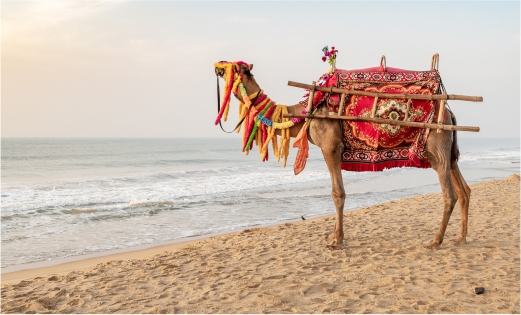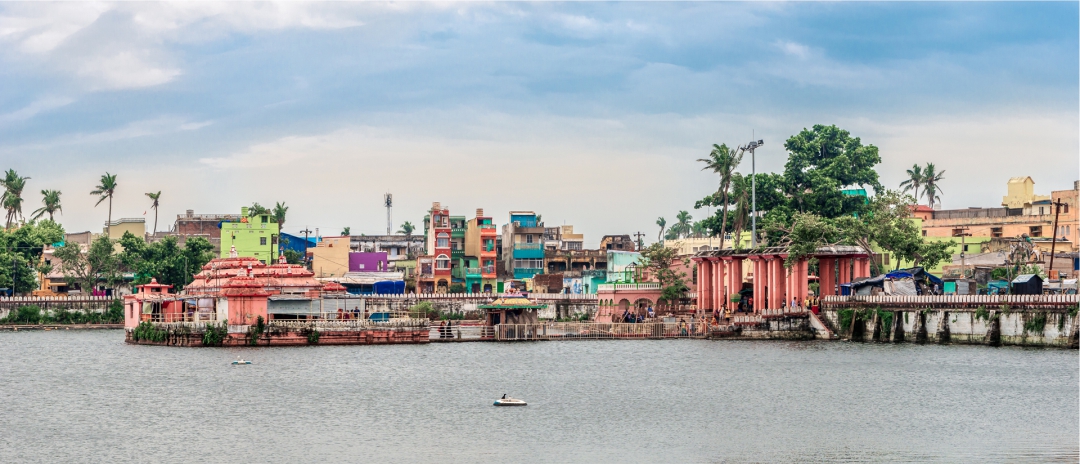Jagannath Temple, Odisha
Been there recently?
The Jagannath Temple in Odisha, which is devoted to Lord Jagannath, an incarnation of Lord Vishnu. The temple itself is a magnificent work of art – built on a raised platform, in such a way that no shadow of the temple falls on the ground at any time of the day. The Ratha Yatra (chariot) festival is annually observed by the temple with great fervour. One of the most popular spiritual extravaganzas in the nation, it draws large crowds. The majestic temple is said to have been built by King Anangabhimadeva of the Ganga dynasty. This magnificent temple dominates the Puri skyline and towers above all nearby structures. Even from the city’s outskirts, one can see its 65 m-high spire. There are 6,000 servants working inside the temple complex, and every day, about 10,000 people are fed in the kitchens. The mahaprasada, or the offering of food to the Lord, is highly revered by devotees. It is prepared in earthen pots over a charcoal and wood fire with rice, vegetables, and cereals. There are numerous other interesting landmarks, such as the Nilachakra or the blue wheel perched atop the temple. The Patitapabana, or the flag that is changed each day at sunset, is perched atop the Nilachakra. The sight of the waving flag is divine to believers. Aruna stambha, also known as the Sun Pillar, is a 33-foot-tall monolithic pillar of black chlorite in front of the Lion Gate that is highly revered. A squatting Garuda, the mythical bird mount of Lord Vishnu, sits atop the pillar’s capital.
Nearby Places to See
Puri Beach
Visitors are enthralled by Puri Beach’s fine golden sands and the Bay of Bengal’s roaring waters all year long. Surfing enthusiasts also prefer the choppy waters of the beach as their preferred location. Visitors can stroll along the beach, look through souvenirs made of pearls and shells sold by locals, or admire stunning sand sculptures. The beach hosts the annual Puri Beach Festival every November, which sees huge footfalls.
Visitors are enthralled by Puri Beach’s fine golden sands and the Bay of Bengal’s roaring waters all year long. Surfing enthusiasts also prefer the choppy waters of the beach as their preferred location. Visitors can stroll along the beach, look through souvenirs made of pearls and shells sold by locals, or admire stunning sand sculptures. The beach hosts the annual Puri Beach Festival every November, which sees huge footfalls.

Markandeswara Temple
It is close to the north of the Jagannath temple and has one of the biggest and most gorgeous ponds. The pond and temple were likely built by Eastern Ganga dynasty kings in the 12th or 13th century.
It is close to the north of the Jagannath temple and has one of the biggest and most gorgeous ponds. The pond and temple were likely built by Eastern Ganga dynasty kings in the 12th or 13th century.
Sudarshan Crafts Museum
Started by a passionate art admirer, it chronicles the development of artistic practice from antiquity to the present day. The museum provides a beautiful setting for works of art while also providing a forum for artists to experiment with new forms of expression.
Started by a passionate art admirer, it chronicles the development of artistic practice from antiquity to the present day. The museum provides a beautiful setting for works of art while also providing a forum for artists to experiment with new forms of expression.
Narendra Tank
Narendra Sarovar, the largest of Puris’ sacred ponds or tanks, is situated to the northeast of the Jagannath Temple. It is also known as Sri Chandana Pukur, and legend has it that during the yearly Chandan Yatra, Lord Jagannath comes here for a boating adventure. The grand Rath Yatra (chariot procession) officially begins with the Chandan Yatra (sandalwood procession). Numerous devotees take a dip in the tank during the yatra in the hope that it will wash their sins away. A temple honouring Lord Jagannath and his siblings, Lord Balabhadra and Goddess Subhadra, is located on a small island in the middle of the tank. Beautifully decorated boats are used to transport the lord around the tank during the festival. Devotees swarm the banks of the water body, dancing and singing as the boats circle the water body.
Narendra Sarovar, the largest of Puris’ sacred ponds or tanks, is situated to the northeast of the Jagannath Temple. It is also known as Sri Chandana Pukur, and legend has it that during the yearly Chandan Yatra, Lord Jagannath comes here for a boating adventure. The grand Rath Yatra (chariot procession) officially begins with the Chandan Yatra (sandalwood procession). Numerous devotees take a dip in the tank during the yatra in the hope that it will wash their sins away. A temple honouring Lord Jagannath and his siblings, Lord Balabhadra and Goddess Subhadra, is located on a small island in the middle of the tank. Beautifully decorated boats are used to transport the lord around the tank during the festival. Devotees swarm the banks of the water body, dancing and singing as the boats circle the water body.

Konark
It is a city 35 kilometres north of Puri. It is the location of The Sun Temple, the finest example of Odisha architecture and a UNESCO World Heritage Site. Narasimha Deva I, king of the Eastern Ganga Dynasty, constructed this enormous and magnificent temple in the 12th century. The temple is fashioned after the Sun God’s chariot, which has 24 exquisite wheels and is drawn by seven horses.
It is a city 35 kilometres north of Puri. It is the location of The Sun Temple, the finest example of Odisha architecture and a UNESCO World Heritage Site. Narasimha Deva I, king of the Eastern Ganga Dynasty, constructed this enormous and magnificent temple in the 12th century. The temple is fashioned after the Sun God’s chariot, which has 24 exquisite wheels and is drawn by seven horses.
Pipili
The village of Pipli, famous for applique and patchwork, is located about 40 km from Puri. Visitors can purchase wall hangings, bedspreads, cushion covers, pillow covers, lampshades, lanterns, puppets, handbags, purses, and more. The applique work dates back to ancient times. On a larger cloth that serves as the base, tiny pieces of cloth with images of flowers, animals, village scenes, and other traditional designs are embroidered and stitched. The creative villagers of Pipli conceptualise and then recreate various, vibrant colour combinations.
The village of Pipli, famous for applique and patchwork, is located about 40 km from Puri. Visitors can purchase wall hangings, bedspreads, cushion covers, pillow covers, lampshades, lanterns, puppets, handbags, purses, and more. The applique work dates back to ancient times. On a larger cloth that serves as the base, tiny pieces of cloth with images of flowers, animals, village scenes, and other traditional designs are embroidered and stitched. The creative villagers of Pipli conceptualise and then recreate various, vibrant colour combinations.
Raghurajpur
Raghurajpur, a traditional crafts village 52 kilometres from Bhubaneswar, is well known for its pattachitra paintings, in which colourful patterns featuring mythological themes are painted on a piece of cloth. In addition, there are tussar paintings, palm leaf engravings, pottery, paper mache products, wooden and stone masks, cow dung toys, and other items that can be purchased by tourists. It may be the only location in India with such a large concentration of artists. Raghurajpur has the distinction of being the first heritage and crafts village to be developed in Odisha. Following this initiative, the village received a rest house, an interpretation centre, and commissioned artworks adorning the artists’ homes.
Raghurajpur, a traditional crafts village 52 kilometres from Bhubaneswar, is well known for its pattachitra paintings, in which colourful patterns featuring mythological themes are painted on a piece of cloth. In addition, there are tussar paintings, palm leaf engravings, pottery, paper mache products, wooden and stone masks, cow dung toys, and other items that can be purchased by tourists. It may be the only location in India with such a large concentration of artists. Raghurajpur has the distinction of being the first heritage and crafts village to be developed in Odisha. Following this initiative, the village received a rest house, an interpretation centre, and commissioned artworks adorning the artists’ homes.
Chilika Lake
The Chilika Lake is Asia’s largest brackish water lake, covering an area of 1,100 square kilometres. Located about 37 km from kilometresri, it is one of the most significant ecotourism destinations in the nation. Over 100 different species of fish, crabs, and other sea creatures can be found in Chilika, but the endangered Irrawaddy dolphin is the main draw due to its special location and water composition. Numerous migratory birds congregate here in the winter, with pink flamingos being the most popular. The shallow waters of the lake surround a sizable area of marshes, lowlands, and islands, the two most notable of which are Kalijai Island and Nalbana Island.
The Chilika Lake is Asia’s largest brackish water lake, covering an area of 1,100 square kilometres. Located about 37 km from kilometresri, it is one of the most significant ecotourism destinations in the nation. Over 100 different species of fish, crabs, and other sea creatures can be found in Chilika, but the endangered Irrawaddy dolphin is the main draw due to its special location and water composition. Numerous migratory birds congregate here in the winter, with pink flamingos being the most popular. The shallow waters of the lake surround a sizable area of marshes, lowlands, and islands, the two most notable of which are Kalijai Island and Nalbana Island.

Bhubaneswar
The capital of Odisha, Bhubaneswar, is one of India’s oldest cities and a significant site for Hindu pilgrimage. With several popular temples dominating its skyline, it is widely considered to be the seat of Tribhubaneswar or Lord Lingaraj, an incarnation of Lord Shiva. The city is peppered with lush parks, gardens, and bodies of water that make for peaceful retreats. It is renowned for its indigenous crafts, including metalwork, appliqué work, pattachitra paintings, and silver filigree. Due to its location on the Mahanadi delta, Bhubaneswar is surrounded by a diverse terrain made up of river basins, forests, and wetlands, providing visitors with numerous opportunities to enjoy the region’s diverse flora and fauna.
The capital of Odisha, Bhubaneswar, is one of India’s oldest cities and a significant site for Hindu pilgrimage. With several popular temples dominating its skyline, it is widely considered to be the seat of Tribhubaneswar or Lord Lingaraj, an incarnation of Lord Shiva. The city is peppered with lush parks, gardens, and bodies of water that make for peaceful retreats. It is renowned for its indigenous crafts, including metalwork, appliqué work, pattachitra paintings, and silver filigree. Due to its location on the Mahanadi delta, Bhubaneswar is surrounded by a diverse terrain made up of river basins, forests, and wetlands, providing visitors with numerous opportunities to enjoy the region’s diverse flora and fauna.




